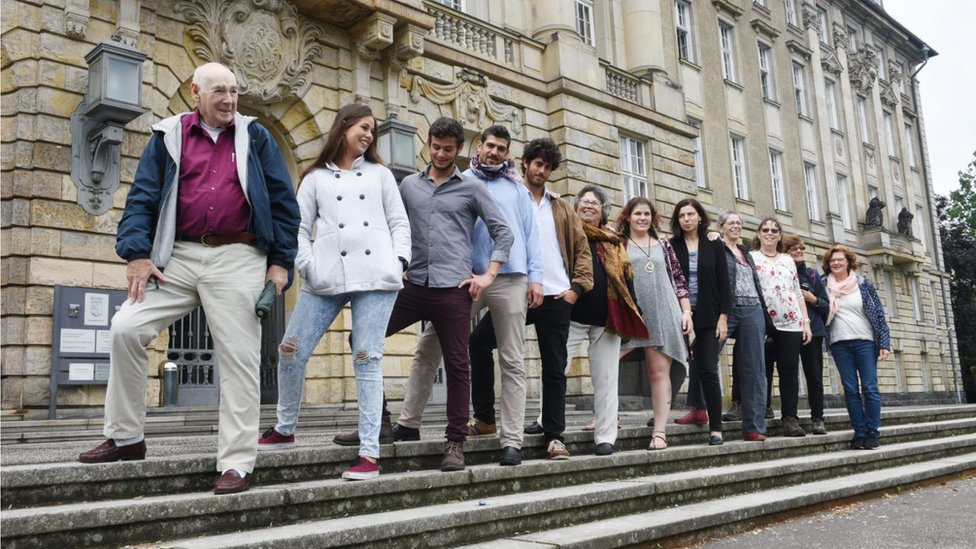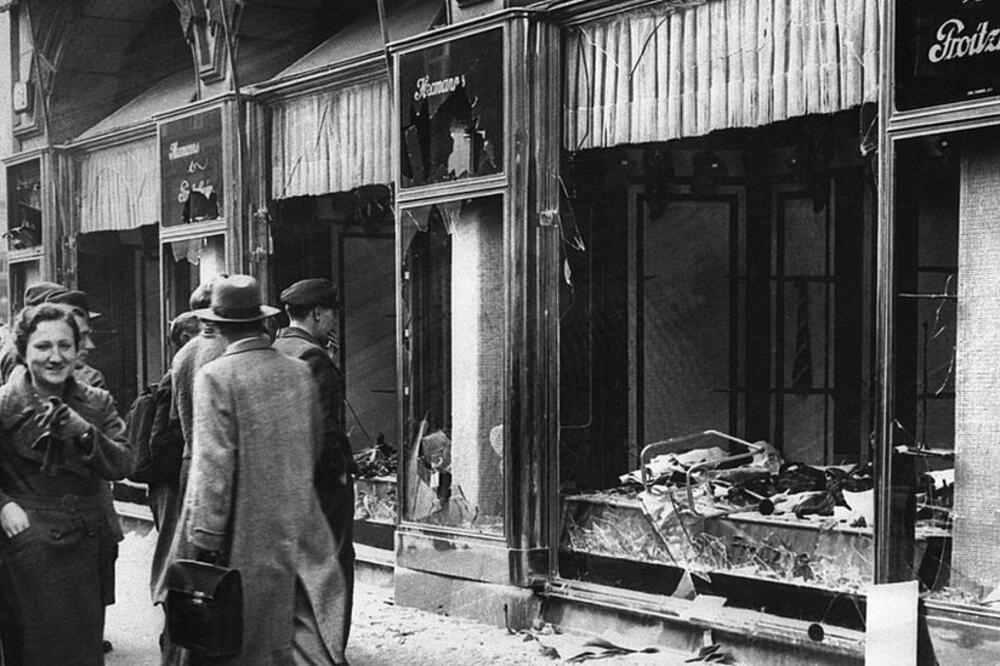A group of 50, 60 people jeers, while a Jewish vendor tries to erase anti-Semitic graffiti from the sidewalk.
Hats and broken glass were strewn all over the road in front of the destroyed Jewish-owned hat shop.
Six-year-old George Sheffey observes this in front of his Berlin apartment building after the Nazi pogroms in November 1938.
"I still have that image in my mind, all the hats and glass, like it was yesterday," says he, now 92 and living in Israel.
- The girl who attended Kristallnacht
- The Nazi Flame That Consumed Books of the "Un-German Spirit"
- Software that helps keep Holocaust victims from being forgotten
- Nazi camp Dachau: How one of the survivors helped to convict the "sadists"
George escaped from Nazi Germany as a small child without parents.
He was one of around 10.000 mostly Jewish children evacuated to Great Britain after the attack, as part of what became known as Britain's "Kindertransport" programme.
George has now returned to Berlin, for the 85th anniversary of the pogrom, to repeat his childhood journey, specifically his escape from Nazi Germany.
He remembers the smashed shops outside his house on Huptstrasse in Berlin's Schöneberg district and being told not to go outside for several days after the pogrom.
He was shocked to learn that his school, which was next to the synagogue, had been burned to the ground.
But he didn't know that this was happening all over Germany, and he didn't realize that his life would change forever.

On the night of November 9, 1938, Nazi mobs went on a rampage across the country, destroying Jewish-owned shops and homes, and burning nearly all of Germany's synagogues to the ground.
91 Jews were killed and 30.000 Jewish men were sent to concentration camps.
George's mother Marie was fully aware of what was happening.
It was the moment she made the painful decision to send George to safety in the United Kingdom herself.
The November pogroms, sometimes called Kristallnacht, marked a turning point in Hitler's persecution of the Jews.
After such brazen and uncontrolled anti-Semitic violence, German Jews suddenly realized that they were not safe.
Those who could, left the country, the rest tried to take the children to safety.
By July 1939, Marie managed to arrange a place for George on the Kindertransport.
"My mom said in the evening: 'Choose toys, tomorrow you will go by train and ship, you will see another country and learn another language. Wonderful!'".
George said his mother tried to make it sound like a fun trip.
"Adventure!" he thought.

In the end, he couldn't pick up any toys.
Children were only allowed a small, sealed suitcase with essentials.
Some children left with only their name tag.
Marie took George to Berlin's Friedrichstrasse station, where he boarded a train full of children trying to escape.
"It was terrible because all those parents were parting with their children.
"I didn't understand what was happening. I could see my mother running along the platform trying to find me and wave me goodbye," says George.
He could see her, but since the train was full, she couldn't see him.
Little did George know that would be the last time he would ever see his mother.
Marie Spiegelglas was taken to the Auschwitz concentration camp in 1943, where she was killed a few hours after her arrival.
Watch the video: Kristallnacht Anniversary - We fought to stay alive
The Kindertransport program was supported by the British state, but relied on funding from non-governmental organizations, donations and volunteers.
The British government has abolished visas for children, but not for their parents.
Most of them perished in the Holocaust.
George says that for those children who ran away, it was traumatic to come to England and choose foster families you never met and whose language they didn't understand.
"It was like a cattle market.
"If you're a five-year-old girl with blonde hair and blue eyes, you'd usually get a good family.
"And if you're a 17-year-old kid and your nose is a bit crooked, someone would take you in as a cheap servant," he says.
There was no supervision of foster families, and some children admitted later said they suffered emotional or physical abuse.

On the site of the former George's School in Berlin, a wall of memorial stones in the playground commemorates local Jews killed in the Holocaust, including Marie.
George is back here to talk to a class of 11-year-old German schoolboys about his own life.
"It must be really, really hard for a mother. Put your child on the train and you never see him again," says one Tuana student.
The children presented George with a box containing a piece of tile, a remnant of his school building that burned down in the pogrom.
This is part of a journey where George and two other survivors retrace their steps, traveling by boat and train from their childhood homes in Germany to London's Liverpool Street railway station, where the Kindertransport children were met by foster families or relatives.
Organizers of this trip, like Scott Sanders, believe that events like this are more important than ever, given what is happening in the Middle East with the war between Israel and Gaza.
"When you look at the world today and you see the growth of anti-Semitism and hatred in all its forms, whether it's Islamophobia, or homophobia, we have a responsibility to stand up and say: no, never again has to mean never again," said Sanders, who works for the March. of the United Kingdom, a Holocaust education charity.

At the age of 13, George embarked on a second independent trip, this time by ship to the USA.
When he was 18, he immigrated to Israel, where he joined the navy and started a family.
I asked George how he survived the trauma of loss and separation.
"I have been lucky in my life. Being in the Kindertransport and being thrown out of Germany is not lucky," he admitted with a smile.
"But on the other hand, I met a lot of people who helped me, I got a good family and I turned 92 years old. So really, I can't complain about that 'guy' up there," he adds.
He returned to Berlin many times with his family to talk to the people to make sure that history is never forgotten and never repeated.
On every trip, they have a tradition: George is photographed in the same place where, almost 90 years ago, he was photographed as a little boy - smiling and unaware of what was about to happen.
Later photos show him returning to the same place, defiant with his family that has been expanding year by year.
George Sheffey's children, grandchildren and great-grandchildren are his final victory over Hitler.
See also this story:
Follow us on Facebook,Twitter i Viber. If you have a topic proposal for us, contact us at bbcnasrpskom@bbc.co.uk
Bonus video:




